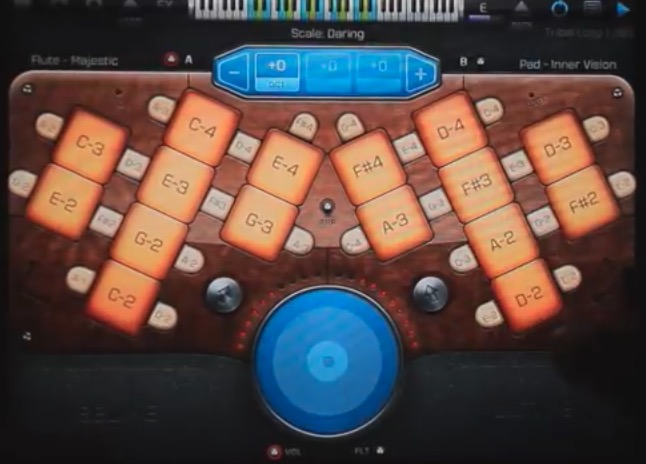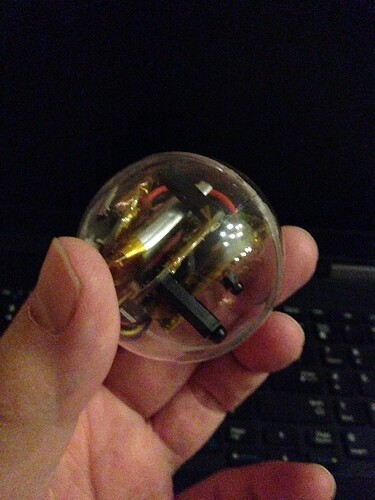I noticed you can buy an Hx711 + 1KG to 20KG max Load Cell for $1.12 + $2.34
(12 covering an octave, would total $23.15 delivered)
An iPad app, I’ve always liked that is not a poor imitation of a real world instrument. Though the “can’t play a bad note” scales are a bit like a Marimba. (MIDI interface was an in-app option)
Over 10 years old, I am not sure you can still find a Seline

Short demo of a later refinement
A walkthrough of the interface.
The GEOSYNTH was another bendy note example with eastern, asian influence.
Post-tonal 12 TET alternative midi controller.
In the last year, I bought a Zynthian, and an Adafruit BNO085 breakout board and nRF52840 Itsy Bitsy Express, and started learning Pure Data and Circuit Python. My aim was a small, spherical, cordless sensor that sends 3D orientation as useful midi signals to and through the Zynth. Originally, I was thinking, modestly enough, about using the four quaternion parameters that are output by the BNO085 (and maybe even the Zynth TOF capabilities) to simultaneously modulate multiple patch parameters in some simple, hopefully interesting, synergetic fashion. But somewhere along my path, I found myself gyring down a proverbial rabbit hole, through the core and up the other side.
I’m now looking at using 3D orientation to select chords, with the quaternion unit vector parameters selecting a pitch constellation and the rotation scaler contributing to the transposition. I’m moving towards a mapping of all sixty-two three or four-pitch constellations to the sixty-two faces of a rhombicosidodecahedron on the conceptual quaternion unit sphere. (Technically the nearest vertices of a deltoidal hexecontahedron, but it’s easier to describe using the dual.) However, since the total number of ways of ordering 62 things dwarfs the number of particles in the visible universe and I’m already an old man, I may not actually find the singular, revelatory pattern I’m hoping to disclose any time now.
In all seriousness though, I’m seeing interesting qualities in a particularly intriguing mapping that assigns (among other criteria) the 12 four-class pitch constellations with two P4/P5 intervals to pentagonal faces, while the 29 three and four-class constellations with one P4/P5 (also adding in the sus triad) are linked to the squares, and the 20, no-P4/P5 constellations assigned to the triangles.
It’s looking interesting enough to announce my efforts here. First and foremost, to thank the community for manifesting the spirit that buoys me every day. And secondly to date this idea as an original (to my knowledge) open hardware/software project for any and all to freely benefit from and improve upon.
(And never dream patent or copyright.)
That’s easy for you to say ![]() .
.
Have you built a prototype? May we see it? This sounds fascinating and as you say, would probably be more useful if tamed by some configurable rules. Do you envisage configurations that allow it to play certain musical pieces, e.g. one configuration for one song, etc? Is the output MIDI? Is it purely notes (chords) or have you considered modulation of MIDI controllers?
@riban
Heres what I’ve put together so far:
They folded nicely into a “50mm refillable acrylic ornament ball” as pictured. The battery lasts a couple of days. Four nylon standoffs and screws in the corners of the sensor keep the output true to the sphere. I think. A silicone band also helps keep things from banging against eachother.
Midi BLE in Circuit Python is somewhat problematic, but I had it outputing pitch constellations as midi notes 0 to 11 to a Pure Data patch on an old Acer Chromebook and the onboard BT 4 running Ubuntu Studio 20.04 I think it was and using the Jack BT midi capability.
My first implementation simply mapped the four quaternion values of the I2C output on the BNO085 to 0 through 11, so it was interesting but unusable. No way to find the same four pitch classes again as I turned the ball in my hands. No real sense that anything much better than randomness was going on. I then realized I needed to map to specific regions of the unit sphere and was pleased to be able to code the nRF52840 board and predictably orient and reorient the sphere to one of sixty-two similarly sized areas using the implied vector of the first three quaternion values. But that code was using a distribution of points on a unit sphere from http://neilsloane.com/packings/dim3/ . And I’ve since decided to use the Rhombicosidodecahedron distribution. That was all too many weeks ago as I’ve concentrated on the question of what pitch classes should go where. Rather than coding. I’m also thinking of using a larger sphere which should be more “playable” and maybe some buttons and this Feather board with the lipo charger built in since itsy-bitsy isn’t really more useful.
Adafruit Feather nRF52840 Express : ID 4062 : $24.95 : Adafruit Industries, Unique & fun DIY electronics and kits
I don’t know what the practical value will be. I’m looking forward to rotating the sphere and hearing what progressions arise from the mathematically interesting orientation that is currently presenting itself and some as yet undiscovered relation between the quaternion scalar parameter and the transposition/mode/key/scale or something. The possibility of all possible three and four pitch class combinations of twelve tone equal-tempered octave being meaningfully and handily in play intrigues me. The questions of the dimentionality of music and how the linearity of the piano keyboard say, or the two dimensions of a score page or fretboard or even the Linnstrument play into the experience. It’s all more a meditation I suppose than an engineering project. Are the weighty simplistic linear hierarchies implicite in what most people call music as limiting and true and obsolete as the single velocitiness of the harpsichord once was? Is democratization what Rap is really about? What’s the relationship between technology and artistic inovation. I think of things like German dyes and Impressionism. Or statistics really taking off only after dice began to be uniformly manufactured. This whole 3D thing and the promise of alternative midi is probably as old Percival and the holy Grail, if I understand anything about the illusory aspects of past present and future. I try to imagine all that was lost in the difference between keys when that wacky Bach started messing with things, but I can’t tell the German 6th from a dominant seven and it probably has nothing and everything to do with battle of Stalingrad. What was the question again?
Cool stuff. I’m impatient for hearing what kind of music it produce.
Yes me too. Now that I’ve gotten a PSS-F30 to dazzle the toddler whose care occupies most of my week days, I’m hoping she’ll leave me and my laptop alone and I can really get cranking. Incidently, when I put You-Tube Bulgararian Choirs or Tuvan throat singers up on the big screen, she has marked tendency to sit on the little keyboard instead of use her hands. May be nothing or may be the universe giving me some hints about cross-cultural chord voicings.
@le51
In the meantime, as I puttter on, I’m reminded of the idea of “writing about music is like dancing about architecture” to which I answer, yes well, don’t stop:
I mispoke. I remember now that the version of Ubuntu Studio I was using required a lot of futzing around to get BLE working in some version of BT 5. (I didn’t have the RAM required to load 21.04.) I don’t think the internet guides describing the required dependencies and installing BlueZ is what finally did it, but an update that came down the pike as I was struggling with it on 20.04. My apologies. I’m really acting well beyond my pay grade here and that rig gave up the ghost some time ago. I’m anticipating the 21.04 I’m using now won’t present the same headaches. But I haven’t actually tried it yet. Anyway the goal is BLE midi on the Zynth, which is still a ways of for me.
I hoped a reference sphere would make isolating the 3 axis a little easier for the operator, I fould it a bit too difficult, perhaps a light color scheme could give a course indication of angle.
It may be more practical to use a strap on gauntlet that is married to your palm orientation. Ranges would have to be clamped to your flexibility range. This more tightly linked input might lead to an intuitive feel. (Left and right hand would have different ranges)
I just ran across a new addition to the M5 stack family, based on the ESP32, which may work as well.

The Stamps alone sell 5 for $23.90 (Hope their supply chain issue is temporary.)
The [M5StickC PLUS ESP32-PICO, with (short life) rechargeable battery and LCD for $19.95 is useful for ESP32 experiments, though I/O is limited it is in stock.


